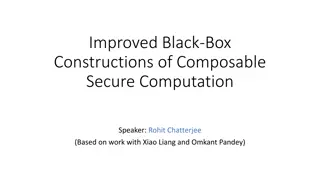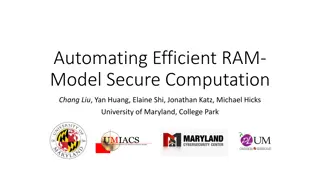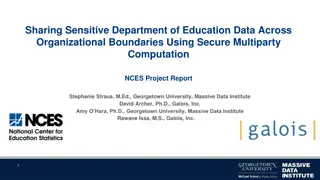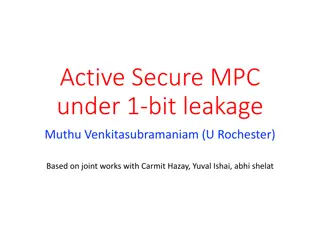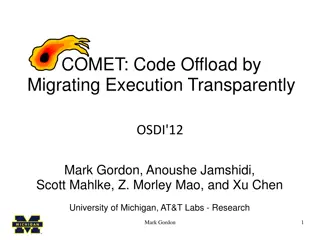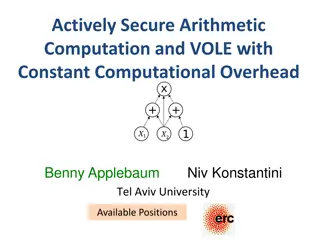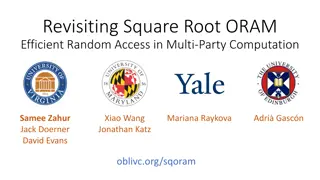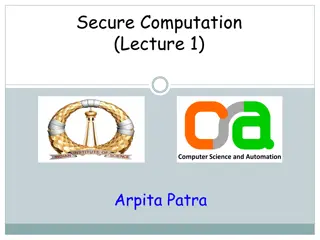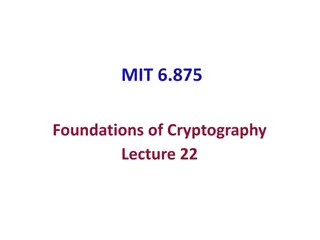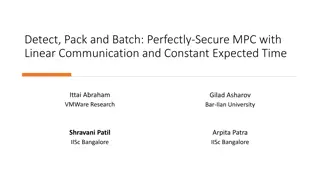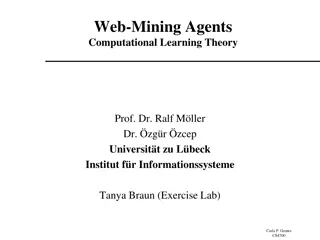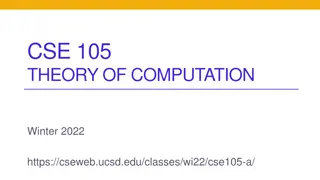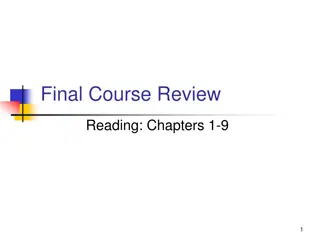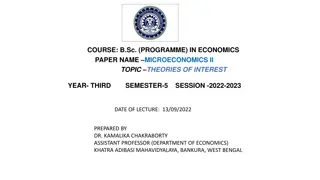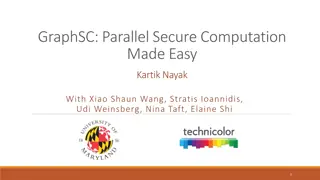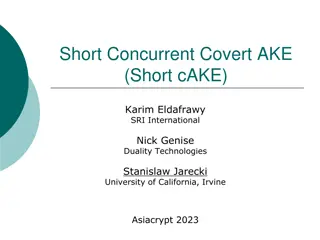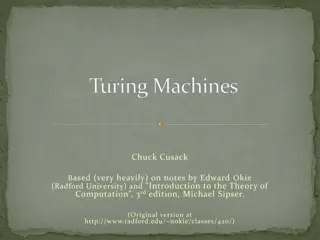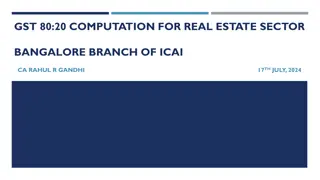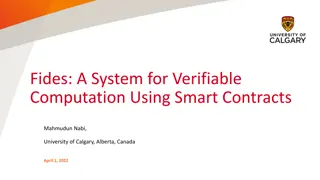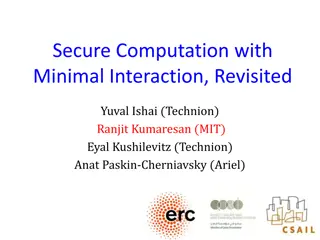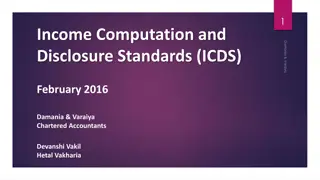Theory of Computation Overview
"Learn about the practical applications of Theory of Computation, including finite automata, regular expressions, Turing machines, and computer architecture. Discover the structured exploration of computational models and their limitations and powers."
Download Presentation

Please find below an Image/Link to download the presentation.
The content on the website is provided AS IS for your information and personal use only. It may not be sold, licensed, or shared on other websites without obtaining consent from the author.If you encounter any issues during the download, it is possible that the publisher has removed the file from their server.
You are allowed to download the files provided on this website for personal or commercial use, subject to the condition that they are used lawfully. All files are the property of their respective owners.
The content on the website is provided AS IS for your information and personal use only. It may not be sold, licensed, or shared on other websites without obtaining consent from the author.
E N D
Presentation Transcript
Welcome! 1. Please take a group list (only if you don t have the info already from the email/Moodle) 2. SIT WITH YOUR ASSIGNED DISCUSSION GROUP IN THE ASSIGNED LOCATION (Your group can as a group move elsewhere for future lectures, if you wish) 3. Introduce yourselves 4. Memorize your group members faces so you can find them on Thursday 1
CSE 105 Theory of Computation Alexander Tsiatas Spring 2012 Theory of Computation Lecture Slides by Alexander Tsiatas is licensed under a Creative Commons Attribution-NonCommercial-ShareAlike 3.0 Unported License. Based on a work at http://peerinstruction4cs.org. Permissions beyond the scope of this license may be available at http://peerinstruction4cs.org.
What is Theory of Computation? The content of many CS courses is perhaps self-explanatory: Programming in Java Compilers Artificial Intelligence For many of you, what exactly will be covered in Theory of Computation may be somewhat mysterious Lets EMBRACE it! Mystery is exciting 3
What is Theory of Computation? Incredibly Practical Finite Automata Hardware design, software engineering Regular Expressions A must-have programmer s tool and resume skills bullet point Foundational for many programming and scripting tasks (Perl) Context-Free Grammars Linguistics Artificial Intelligence Machine translation (English->Korean) Turing Machines All modern computers and programming languages! Computer architecture (CPU/instructions + RAM) 4
What is Theory of Computation? Breathtakingly Beautiful 5
How is this exploration of Theory of Computation structured? Weak = limited uses Powerful = versatile Venn Diagram We will examine a series of abstracted models of computation machines Start with the most limited Move towards the most versatile* Along the way, Learn how to use each model as a handy tool in your programming life Become familiar with the contours of each model s limitations and powers Prove things about the limitations, about the powers, and about the relationships between models * Fun fact: this simple-to-complex order is not always the same order in which these were created/discovered DFA TM 6
Who Am I? Soon to be Ph.D. in Computer Science from UCSD Graph diffusion and clustering problems Courses I ve TA d at UCSD: 105 (twice!), 200, 202 (three times ) What do I do when I m not teaching? Other jobs and research projects: Several years internship experiences at Google and Bell Laboratories Some work in machine learning theory research 7
What do I do in this course? Be your guide in inducing you to explore concepts Create situations and pose problems that set the scene for your exploration Me: mise en sc ne You: actor/actress Provide you with feedback Evaluate your progress Answer your questions Not spend lecture reading the textbook to you with slightly different words 8
What do you do in this course? Prepare your brain for maximum in-class learning Reading, reading quizzes In class: engage with yourself, your neighbors and the class, engage with the ideas turn them upside down and sideways iClickers, group discussion Solidify, refine and perfect your skills Homework Certify what you ve learned, celebrate victories, redirect as needed Exams Seek help and seek to help others In class, moodle forums, office hours, discussion section The ideas, not your neighbors 9
Rules for what you do in this course Reading quizzes Yes: Open book; though being able to answer without the book is a good sign You can retry a question if you answer incorrectly (small penalty), and you can take as much time as you need Complete them individually No: Sharing answers on a reading quiz is as inappropriate as sharing answers on an in-class exam don t do it There is really, really no reason to cheat 10
Rules for what you do in this course Exams Yes: I will provide notes (theorems and other reference) with the exam booklet Ask instructor or TA for clarification No: Closed book Closed neighbors and all other unauthorized assistance 11
Rules for what you do in this course Homework Yes: Open book, open lecture slides and notes, open moodle forums and resources Working with ONLY your authorized partner, as long as you are both working. It is extremely important that you be prepared to come up with proofs by yourself so you will be ready for the exams No: Do not Google for solutions or look for any resources that aren t provided in moodle or otherwise explicitly authorized Do not split up the problems with your homework partner 12
Rules for what you do in this course Class Participation Yes: Click in and engage actively with your group and with me, even when (or especially when!) you are unsure or struggling The only way to get through a struggle is to work If you let me know that you are struggling, by asking a question or by clicker response, I can help this is a huge favor to me because it helps me steer the lesson in the most helpful direction Treat other class members kindly and be conscious of creating a welcoming, positive, collaborative team environment No: No clicking in for someone who isn t here, or otherwise feigning participation I know that everyone has off days, sleepy days, etc, and that s fine. But please don t ever allow your behavior to become distracting or rude to anyone else Mention email etiquette 13
Thought of the Week To be a good geek you have to have both humility and arrogance in equal measures. The humility is so you ll admit you don t know something and get help/read the docs/etc. The arrogance is the bit that says I don t know that now but I can and I will soon. --Thomas Beagle, IT/programmer 14
Getting started to-do list: 1. 2. Register your iClicker at http://iclicker.com Join our class on Moodle (reading quizzes, other critical stuff): http://csemoodle.ucsd.edu Log in using ActiveDirectory username/password Join our class on UP (lecture slides): http://up.ucsd.edu classroom: CSE 105 SP12 password to join class: recursive (if you don t have an account, make one it will have its own password) Get to know your group You need to memorize their faces so you can sit by them on Thursday Take the prerequisite/Ch 0 self-test Take the Sec 1.1 Reading Quiz (if you haven t already) before Thursday s lecture Download the JFLAP software for designing and simulating automata, get it running on your system (it is a .jar file, you need Java) Go to discussion Friday or Monday for proof-writing tips Homework 1 will go out tomorrow evening 3. 4. 5. 6. 7. You don t know what automata is, do you? SOON! 8. 9. 15
Textbook concerns Introduction to the Theory of Computation by Michael Sipser Full 2nd edition Custom 2nd edition 1st or international editions 3rdedition comes out soon 16
What other classes are you taking this quarter? 17
Lets get started! AUTOMATA COMPUTATIONAL MODELS 18
What Do Automata Do? Input strings, output accept or reject Every automaton is defined over an alphabet Ex: = {a,b,c, ,z} or = {0,1} What does a particular automaton do? 1. Test every possible string made from 2. Come up with a set of all the strings that were accepted 19 Language
They have almost no memory! DETERMINISTIC FINITE AUTOMATA DFA 20
DFA Show 001 very quickly 21
Tracing in a DFA a) q0, q1, q2, q2, q3 b) q0, q1, q1, q2, q2, q3 c) q0, q1, q1, q1, q2, q2, q3 d) q0, q1, q1, q1, q1, q2, q2, q3 What is the sequence of states that are followed when running this DFA on the input 111001 ? 22
Tracing in a DFA a) q0, q1, q2, q3 b) q0, q1, q2, q3, q3 c) q0, q1, q2, q3, q3, q3 d) q0, q1, q2, q3, q3, q3, q3 What is the sequence of states that are followed when running this DFA on the input 001000 ? 23
Quick review of set notation Let s dissect this (assume = {0,1}): L1 = { w | length(w) > 3} 24
Quick review of set notation Which choice is NOT a string in language L1 ? ( = {a,b,c}) a) abbcbba b) cab c) bba d) bccccbcccc e) bacb L1 = {w | w contains more b s than a s} 25
Which is the best description of the language recognized by the DFA M1? ( = {a,b}) a) Starts with b and ends with a or b b) Starts with a and ends with a or b c) a s followed by b s M1: 26
Which is the best description of the language recognized by the DFA M2? ( = {a,b}) a) Starts with b and ends with b b) Starts with a and ends with b c) b s followed by a s M2: 27
Communication: An important skill Describing languages clearly and concisely, like we did in the last problem, is going to be a skill we work on frequently in this course. Also an issue in proof-writing: Being concise is a virtue But leaving out important details is a problem A conundrum!! Examples, practice, feedback More examples, more practice, more feedback Homework and exams are an official way of doing practice and feedback, but time constraints (yours and the TA s) limit frequency A key reason I do group discussion in this course is to provide more opportunity for you to practice putting theoretical ideas into words learning how to be precise, concise and convincing 28
Which states should be in F (the set of final or accept states) so that DFA M1 recognizes the language L1 = {w | b s never appear after a s in w} ( = {a,b}) M1: a) F = {q2} b) F = {q3} c) F = {q1, q2} d) F = {q1, q3} e) F = {q2, q3} 29
Which states should be in F (the set of final or accept states) so that DFA M2 recognizes the language L2 = {w | w contains less than 1 a or more than 1 a}? ( = {a,b}) M2: a) F = {q2} b) F = {q3} c) F = {q1, q2} d) F = {q1, q3} e) F = {q2, q3} 30
Remember Remember I said that in this course, we would, Become familiar with the contours of each model s limitations and powers Prove things about the limitations, about the powers Not too early to start thinking about this for DFA, so: TRUE (a) OR FALSE (b): Deterministic Finite Automata (DFAs) can only recognize finite languages (a language with 1 string or 2 strings or 10 strings or 1,000,000 strings in it), not infinite languages (infinite number of strings in the language) 31
Its from Duke University! AUTOMATA SIMULATION SOFTWARE JFLAP What is deterministic? 32
Getting started to-do list: 1. 2. Register your iClicker at http://iclicker.com Join our class on Moodle (reading quizzes, other critical stuff): http://csemoodle.ucsd.edu Log in using ActiveDirectory username/password Join our class on UP (lecture slides): http://up.ucsd.edu classroom: CSE 105 SP12 password to join class: recursive (if you don t have an account, make one it will have its own password) Get to know your group You need to memorize their faces so you can sit by them on Thursday Take the prerequisite/Ch 0 self-test Take the Sec 1.1 Reading Quiz (if you haven t already) before Thursday s lecture Download the JFLAP software for designing and simulating automata, get it running on your system (it is a .jar file, you need Java) Go to discussion Friday or Monday for proof-writing tips Homework 1 will go out tomorrow evening 3. 4. 5. 6. 7. You don t know what automata is, do you? SOON! 8. 9. 33


